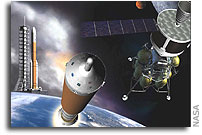NASA ESAS Final Report November 2005: Section 2.0 Introduction

 Editor’s note: DOWNLOAD THIS SECTION (PDF)
Editor’s note: DOWNLOAD THIS SECTION (PDF)
2. Introduction
2.1 Background
Editor’s note: several days ago we posted a final (October 2005) draft of this report. We have since come across a complete copy of the final version of the report (November 2005) which has recently been approved by NASA Administrator Michael Griffin. In order to present the most accurate version of this report, we have removed the draft version and replaced it with the final version of the report. NASA is expected to publicly release this report in early January 2006.
In January 2004, President George W. Bush announced a new Vision for Space Exploration for NASA that would return humans to the Moon by 2020 in preparation for human exploration of Mars. As part of this vision, NASA would retire the Space Shuttle in 2010 and build and fly a new Crew Exploration Vehicle (CEV) no later than 2014. Initially, since no plans were made for this CEV to service the International Space Station (ISS), international partner assets would be required to ferry U.S. crew and cargo to the ISS after 2010—creating a significant gap in domestic space access for U.S. astronauts. NASA gradually reorganized to better implement the President’s vision and established the Exploration Systems Mission Directorate (ESMD) to lead the development of a new exploration “system-of-systems” to accomplish these tasks. Over the course of the next year, ESMD defined preliminary requirements and funded system-of-system definition studies by Government and industry. More than $1 billion in technology tasks were immediately funded in a wide variety of areas. Plans were established to spend more than $2 billion per year in exploration systems, human, and nuclear-related technologies. Plans were established to fund two CEV contractors through Preliminary Design Review (PDR) and first flight of a subscale test demonstration in 2008, after which selection of a final CEV contractor would be made. In March 2004, a CEV Request for Proposals (RFP) was released to industry despite the lack of a firm set of requirements or a preferred architecture approach for returning humans to the Moon. A wide variety of architecture options was still under consideration at that time—with none considered feasible within established budgets. Preferred architecture options relied on as many as nine launches for a single lunar mission and relied on modified versions of the United States Air Force (USAF) Evolved Expendable Launch Vehicles (EELVs) for launch of crew and cargo.
Dr. Michael Griffin was named the new NASA Administrator in April 2005. With concurrence from Congress, he immediately set out to restructure NASA’s Exploration Program by making it a priority to accelerate the development of the CEV to reduce or eliminate the planned gap in U.S. human access to space. He established a goal for the CEV to begin operation in 2011 and to be capable of ferrying crew and cargo to and from the ISS. To make room for these priorities in the budget, Dr. Griffin decided to downselect to a single CEV contractor as quickly as possible and cancel the planned 2008 subscale test demonstration. He also decided to significantly reduce the planned technology expenditures and focus on existing technology and proven approaches for exploration systems development. In order to reduce the number of required launches and ease the transition after Space Shuttle retirement in 2010, Dr. Griffin also directed the Agency to carefully examine the cost and benefits of developing a Shuttle-derived Heavy-Lift Launch Vehicle (HLLV) to be used in lunar and Mars exploration. To determine the best exploration architecture and strategy to implement these many changes, the Exploration Systems Architecture Study (ESAS) team was established at NASA Headquarters (HQ) as discussed in Section 2.2, Charter, and Section 2.3, Approach.
Table of Contents
This large 50 MB PDF report has been subdivided into 17 PDF files – one for each of the report’s 17 sections. Click on the link at the top of each section to visit a summary page and to download that section.
Editor’s note: several days ago we posted a final (October 2005) draft of this report. We have since come across a complete copy of the final version of the report (November 2005) which has recently been approved by NASA Administrator Michael Griffin. In order to present the most accurate version of this report, we have removed the draft version and replaced it with the final version of the report. NASA is expected to publicly release this report in early January 2006.
- 1. Executive Summary
- 2. Introduction
- 3. Ground Rules and Assumptions
- 4. Lunar Architecture
- 5. Crew Exploration Vehicle
- 6. Launch Vehicles and Earth Departure Stages
- 7. Operations
- 8. Risk and Reliability
- 9. Technology Assessment
- 10. Test and Evaluation
- 11. Integrated Master Schedule
- 12. Cost
- 13. Summary and Recommendations
- 14. Architecture Roadmap
- 15. Architecture Advantages
- 16. ESAS Core Team Members
- 17. Acronyms and Abbreviations








